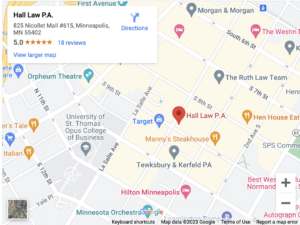Personal Injury Law Resources
- How Are Pain and Suffering Damages Calculated?
- How Much Is My Minneapolis Personal Injury Case Worth?
- Out-of-Pocket Expenses
- Personal Injury FAQ
- What Are Economic Damages?
- What Are Non-Economic Damages?
- What Are Punitive Damages?
- What Does It Cost to Hire a Personal Injury Lawyer?
- What Is A Contingency Fee?
- What Is Breach of Duty?
- What Is Causation?
- What Is Evidence?
- What Is Loss of Consortium?
- What Is Negligence?
- What Is Negotiation in a Personal Injury Case?
- When Should I Hire a Minneapolis Personal Injury Lawyer?
Types of Injuries
Government Resources
- Distraction.gov — The official US Government website for distracted driving
- National Safety Council — a nonprofit organization whose mission is to save lives by preventing injuries and deaths at work, in homes and communities and on the road through leadership, research, education and advocacy.
- US Department of Transportation — Serve the United States by ensuring a fast, safe, efficient, accessible and convenient transportation system that meets our vital national interests and enhances the quality of life of the American people, today and into the future.
- National Highway Traffic Safety Administration — dedicated to achieving the highest standards of excellence in motor vehicle and highway safety. It works daily to help prevent crashes and their attendant costs, both human and financial.
Minnesota Resources
- Minnesota Government Website – Find information related to residents, business, government, education, and travel in Minnesota.
- Explore Minnesota – Find things to do, news, and events across the state.
- City of Minneapolis, Official Website – Information about resident services, business services, things to do, and recent news about the city.
- City of St. Cloud, Official Website – Find out more about neighborhoods, transportation, health and public safety, city government, and more.
- City of Edina, Official Website – Read about the latest news of Edina, permits and applications, urbanism plantation, and activities in the city.
- Minneapolis, MN Wikipedia Page – Read information about the area, demographics, culture, history, and more about Minneapolis.
- St. Cloud, MN Wikipedia Page – See relevant data about St. Cloud, history, demographics, population, density, and more.
- Edina, MN Wikipedia Page – Economy of the city, population, and demographics.
Minneapolis Local Resources
Minneapolis Auto Repair Shops
- Uptown Imports – Foreign Auto Repair – 1423 N Washington Ave, Minneapolis, MN 55411
- Baraka Auto Center – 100 5th St NE, Minneapolis, MN 55413
- Firestone Complete Auto Care – 1100 Hawthorne Ave, Minneapolis, MN 55403
- Honest-1 Auto Care – 2217 Lyndale Ave S, Minneapolis, MN 55405
- Clausen Service Center – 22 E Franklin Ave, Minneapolis, MN 55404
Minneapolis Emergency Rooms
- Hennepin Healthcare Emergency Department – 730 S 8th St, Minneapolis, MN 55415
- Hennepin County Medical Center Emergency Room – 900 S 8th St, Minneapolis, MN 55415
- Abbott Northwestern Hospital Emergency Department – 800 E 28th St, Minneapolis, MN 55407
- University of Minnesota Medical Center Emergency Room – 2312 S 6th St, Minneapolis, MN 55454
- East Bank Emergency Department – M Health Fairview University of Minnesota Medical Center – 500 SE Harvard St, Minneapolis, MN 55455
Minneapolis Physical Therapists
- OrthoRehab Specialists, Inc. – 825 Nicollet Mall #1935, Minneapolis, MN 55402
- Southpointe Physical Therapy Llc – 1305 E 24th St, Minneapolis, MN 55404
- Mayo Clinic Orthopedics and Sports Medicine – 600 Hennepin Ave Suite 310, Minneapolis, MN 55403, United States
- Midwest Physical Therapy, LLC – 2801 S Wayzata Blvd, Minneapolis, MN 55405
- PRO Therapy – Northeast – 2112 Broadway St NE Suite 195, Minneapolis, MN 55413
Minneapolis Courts
- US District Court – 300 S 4th St #202, Minneapolis, MN 55415
- Hennepin County Family Court – 110 S 4th St, Minneapolis, MN 55401
- Minnesota 4th District Court – 300 South 6th St, Minneapolis, MN 55487
- Juvenile Court – 590 Park Ave, Minneapolis, MN 55415
- District Court-Civil Office – Hennepin County Government Center, 300 South 6th St, Minneapolis, MN 55487
Visit Our Minneapolis, MN Law Office
Hall Law Personal Injury Attorneys – Minneapolis Office
825 Nicollet Mall, Suite 615
Minneapolis, MN 55402
(800) 292-1979
Mon – Fri 8:00AM – 5:00PM
St. Cloud Local Resources
St. Cloud Auto Repair Shops
- Jim’s Auto Services – 22 16th Ave S, St Cloud, MN 56301
- Advanced Repair Inc – 27 16th Ave S, St Cloud, MN 56301
- Mike’s Repair – 17 Franklin Ave NE, St Cloud, MN 56304
- Preferred Service and Repair – 2205 Roosevelt Rd, St Cloud, MN 56301
- Snappy Auto & Tire – 2510 2nd St S B, St Cloud, MN 56301
St. Cloud Emergency Rooms
- CentraCare – St. Cloud Hospital Emergency Trauma Center – 1406 6th Ave N, St Cloud, MN 56303
- CentraCare Health – Monticello: Emergency Room – 1013 Hart Blvd, Monticello, MN 55362
- CentraCare Plaza Urgent Care – 1900 Centracare Cir, St Cloud, MN 56303
- Abbott Northwestern Hospital Emergency Department – East 28th Street, Minneapolis, MN 5540
St. Cloud Physical Therapists
- Northern Star Therapy Ltd – 1301 33rd St S #210, St Cloud, MN 56301
- Mountain River Physical Therapy – 1521 Northway Dr Suite 116, St Cloud, MN 56303
- Northern Star Therapy Ltd. – 251 Co Rd 120, St Cloud, MN 56303
- NovaCare Rehabilitation – Sartell – 2251 Connecticut Ave S Suite 3600, Sartell, MN 56377
- Rehabilitation Counsel Mn – 425 E St Germain St, St Cloud, MN 56304
St. Cloud Courts
- Stearns County Courthouse – 725 Courthouse Square, St Cloud, MN 56303
Visit Our St. Cloud, MN Law Office
Hall Law Personal Injury Attorneys – St. Cloud Office
1010 West St. Germain St., Suite 320
St. Cloud, MN 56301
(320) 255-1000
Mon – Fri 8:00AM – 5:00PM
Edina Local Resources
Edina Auto Repair Shops
- Grandview Tire & Auto – Vernon – 5100 Vernon Ave S, Edina, MN 55436
- Precision Tune Auto Care – 5353 France Ave S, Minneapolis, MN 55410
- Edina Tire & Auto – 5354 France Ave S, Minneapolis, MN 55410
- Eliot Park Auto Service – 5608 Excelsior Blvd, St Louis Park, MN 55416
- Youngstedts Minnoco Tire & Auto Repair – 5925 Excelsior Blvd, St Louis Park, MN 55416
Edina Emergency Rooms
- Emergency Department – M Health Fairview Southdale Hospital – 6401 France Ave S, Edina, MN 55435
- Methodist Hospital Emergency Center – 6500 Excelsior Blvd, St Louis Park, MN 55426
- Abbott Northwestern Hospital Emergency Department – 800 E 28th St, Minneapolis, MN 55407
- Hennepin Healthcare Emergency Department – 730 S 8th St, Minneapolis, MN 55415
- Hennepin County Medical Center Emergency Room – 900 S 8th St, Minneapolis, MN 55415
Edina Physical Therapists
- Viverant Physical Therapy – 5400 France Ave S, Edina, MN 55410
- Loon State Physical Therapy – 4420 Drew Ave S, Minneapolis, MN 55410
- Orenstein Physical Therapy – 4388 France Ave S suite 220, Minneapolis, MN 55410
- Fairview Southdale Rehab Services – 6401 France Ave S, Minneapolis, MN 55435
- Orthorehab Specialists, Inc. – 6600 France Ave S #260, Edina, MN 55435
Edina Courts
- Hennepin County Court House – 12601 Ridgedale Dr, Minnetonka, MN 55305
- Hennepin County Suburban Court – 6125 Shingle Creek Pkwy #200, Brooklyn Center, MN 55430
- District Court-Jury Office – Hennepin County Government Center, 300 South 6th St, Minneapolis, MN 55487
Visit Our Edina, MN Law Office
Hall Law Personal Injury Attorneys – Edina Office
5200 Willson Road, Suite 203
Edina, MN 55424
(952) 697-5560
Mon – Fri 8:00AM – 5:00PM
*Disclaimer – we do not endorse these companies or profit from having them listed on our website. These were some of the highest-rated auto repair shops on Yelp.
Contact Hall Law Personal Injury Attorneys for a Free Consultation Today
Our experienced personal injury lawyers in Minneapolis, MN, handle all types of personal injury cases, including car accidents, truck accidents, wrongful death cases, boating accidents, sexual assault, nursing home abuse, and more.




